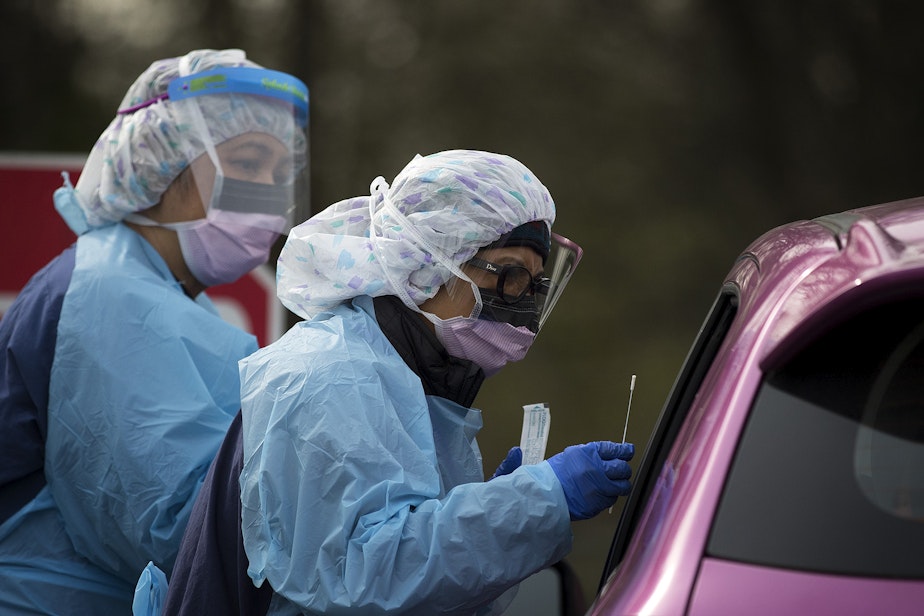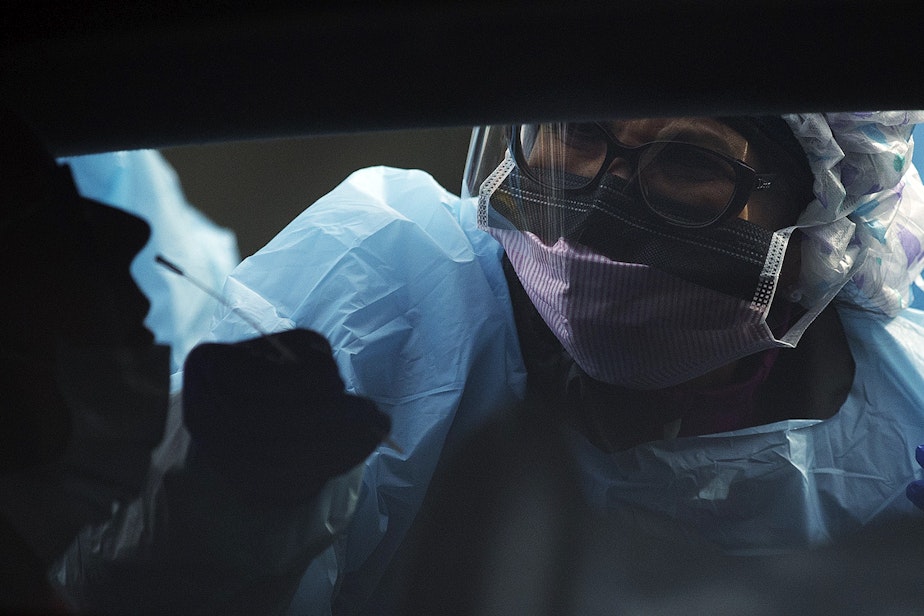Seattle doctors have learned the hard way about coronavirus. Here are some lessons

When the first death in the U.S. from the novel coronavirus was announced, Gaby Berger, an internal medicine physician and assistant professor at the University of Washington was working at the hospital.
“We knew things were going to change quickly,” Berger said.
While initially the plan had been to have only a few senior clinicians working with COVID-19 patients, it soon became clear that that would not be feasible.
“The residents were really nervous about what to do if they were called for patients with respiratory symptoms, and this was before our own test [for COVID-19] was available,” Berger said.
Strict isolation of every patient with shortness of breath, or cough, or fever, wasn’t going to be possible. The infection control team trained everyone quickly in how to use personal protective equipment, and began to plan for when we might run out.
As Washington state has become the center of the nation’s first confirmed outbreak and seen more than half of the death’s so far, local physicians, like myself, have scrambled to respond. Along the way, we have learned hard lessons about communication, planning, and supporting the well-being of staff.
Sponsored

Communication is key
Every morning, James Town, director of the medical intensive care unit at Harborview Medical Center, a public hospital managed by the University of Washington, attends a daily briefing meeting run by hospital leadership on how to handle a surge of patients, isolation practices, and concerns from staff.
“All of this is evolving so rapidly,” Town said.
The meetings are comprehensive and communication is increasingly streamlined, but preexisting “channels were not rapid, or efficient or robust enough” to respond to this crisis in the beginning, according to Town.
Sponsored
“Early on there was a lot of misinformation, and tardiness to deliver the information,” Town said. “That made people anxious, because they felt like they were hearing more from The New York Times or the radio than they were hearing internally.”
In the past few weeks, however, the University of Washington has created an internal and public facing website with clear protocols, held a number of town halls for providers, and started communicating clearly multiple times a day to staff about changing policies.
Town encouraged other institutions to have their own regular meetings, including town halls where providers can express concerns, and to do a lot of active listening because “the people on the front lines are the ones that create the best, fastest, and most workable solutions.”
One of the challenges to effective communication, Berger told me, is that the situation keeps changing, and so too, must our advice. Unanswered questions include how long the virus can be transmitted, the mortality rate, and when this will end. “As health care providers, we are used to having a lot more knowledge than our patients, and we don’t have that right now.”
“This is a time that we need to have grace and flexibility with one another,” Berger said. “The best thing we can do is to have open lines of communication,” and acknowledge the anxiety and uncertainty we are all feeling.
Sponsored
Do no harm
Every time I cough, I pause. Was that the first sign of the virus, or just a tickle in my throat? If I am sick, how many people have I exposed, how many patients might I have harmed?
The anxiety can be crippling but it is not unwarranted. Data from China indicates that almost half of serious COVID-19 infections may have been acquired in healthcare settings. To that end, University of Washington has delayed all elective surgeries and routine follow ups, for the protection of those patients and free up precious equipment, like ventilators. In the past week, we have tried to convert all visits into telemedicine visits.
The ability to do that may be hampered at other institutions that have not been building this capacity, and will run into red tape and financial barriers.
In most states, telemedicine visits are reimbursed at a lower rate, and rules about who can provide the service, to whom, and at what location abound. If new rules are pushed through, however, we may have a way to deal with an increasingly critical shortage of healthcare workers, many of whom are likely to be sick or quarantined in the coming months.
Sponsored

Reaching the public
Communicating changing policies, guidelines, and risk to our patients has been challenging and less streamlined than internal communication.
Eve Lake, a primary care physician at Harborview’s clinic for immigrants as well as its HIV clinic, says she has been trying to do education one-on-one, but that the lack of information is an added burden. This has been particularly challenging for non-English speaking patients, she said, as they might not have access to public health updates.
“I find myself explaining more about the risks, and why we’re offering telemedicine, than I wish I were,” Lake said.
Sponsored
Mixed messages over the past month have muddied the waters, but even with a clear path forward, we can’t a always reach everyone if they’re not plugged in.
Berger, the internal medicine doctor, believes there is a role for influencers and people active on social media. “If they’re not listening to the regular media, I think it’s got to be those people who get the message out. It can’t all be on doctors or public health.”
The emotional toll
Before the current coronavirus outbreak, about half of providers said that they were ineffective, emotionally exhausted, and felt disconnected from their work. Some of the most common reasons given were lack of control over our work environments, and an unreasonable quantity and pace of work. The numbers are greatest in front line specialties, like emergency medicine.
Now these already strained work environments have to take on the brunt of a pandemic. It is unnerving to think about what surge capacity looks like in a system that has asked us to perform at an unsustainable level for decades. For physicians in training, who work an average of eighty hours a week, but can be scheduled for up to a hundred and have high risk of personal injury, the toll may be particularly hard.
Both Berger and Town emphasized that deaths from coronavirus have been traumatic, because people are more likely to die alone.
“They don’t have the ‘good death’ that we try to provide for patients, with lots of family, and palliative care around,” Berger said. “We’ve had residents go in [with masks, gowns, and gloves] and sit with patients, and hold their hand because nobody else could be there.”
The toll on our families has also been high. Lake said she worries about exposing her loved ones, and is practicing the kind of extreme social distancing that many of us think is our only hope to prevent hundreds, if not thousands, of deaths in the next few weeks, including not having house guests or playdates. Some doctors have even made the difficult decision to isolate themselves from their own families.
Lake has sought out ways of staying in touch with other physicians through texts and phone calls.
“Comfort is too strong a word, but I find a lot of solidarity, and I feel less isolated, talking to other providers," she said.
I asked Lake what she wanted other doctors to know outside of Washington.
“This is going to get worse,” she told me after a long pause. “And we all have to hold each other up."
